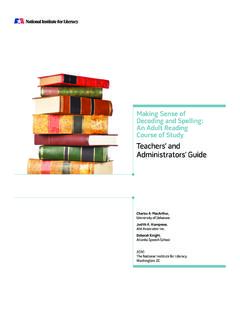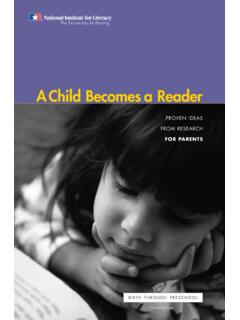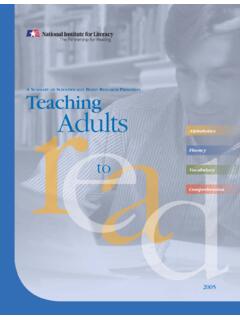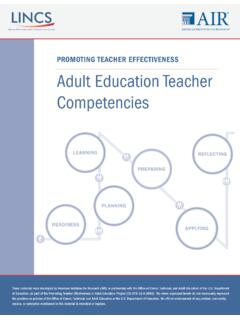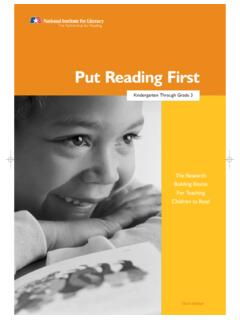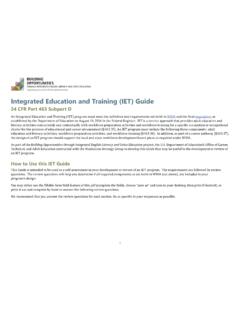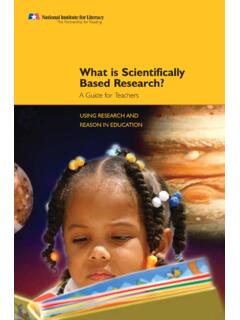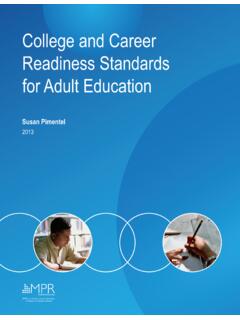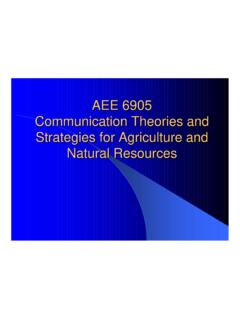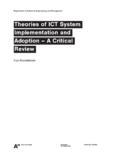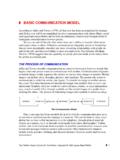Transcription of Adult Learning Theories - US Department of Education
1 TEAL Center Fact Sheet No. 11: Adult Learning Theories 2011 Page 1 Adult Learning Theories What Are Adult Learning Theories ? There is no single theory of Learning that can be ap-plied to all adults . Indeed, the literature of the past century has yielded a variety of models, sets of as-sumptions and principles, Theories , and explanations that make up the Adult Learning knowledge base. The more that Adult educators are familiar with this know-ledge base, the more effective their practice can be, and the more responsive their practice can be to the needs of Adult learners. This fact sheet reviews three major Theories andragogy, self-directed Learning , and transformational Learning and discusses their implications for practice.
2 It also provides a theoretical grounding for the work of the TEAL Center and links readers to many TEAL resources, all of which are available at What Is Andragogy? In attempting to document differences between the ways adults and children learn, Malcolm Knowles (1980) popularized the concept of andragogy ( the art and science of helping adults learn ), contrasting it with pedagogy ( the art and science of teaching child-ren ). He posited a set of assumptions about Adult learners namely, that the Adult learner Moves from dependency to increasing self-directedness as he/she matures and can direct his/her own Learning ; Draws on his/her accumulated reservoir of life experiences to aid Learning ; Is ready to learn when he/she assumes new so-cial or life roles; Is problem-centered and wants to apply new Learning immediately; and Is motivated to learn by internal, rather than ex-ternal, factors.
3 Inherent in these assumptions are implications for practice. Knowles (1984) suggests that Adult educa-tors Set a cooperative climate for Learning in the class-room; Assess the learner s specific needs and interests; Develop Learning objectives based on the learn-er s needs, interests, and skill levels; Design sequential activities to achieve the objec-tives; Work collaboratively with the learner to select me-thods, materials, and resources for instruction; and Evaluate the quality of the Learning experience and make adjustments, as needed, while assess-ing needs for further Learning . Because adults need to know why they are Learning something, effective teachers explain their reasons for teaching specific skills. Because adults learn by doing, effective instruction focuses on tasks that adults can perform, rather than on memorization of content.
4 Be-cause adults are problem-solvers and learn best when the subject is of immediate use, effective instruction involves the learner in solving real-life problems. (For additional ideas on ways to actualize these sugges-tions, refer to the TEAL Fact Sheet No. 6 on Student-Centered Learning .) Andragogy is not without criticism. Brookfield (2003) called the theory "culture blind," stating that the con-cept of self-directed Learning and the concept of the student s establishing a non-threatening relationship with the teacher as facilitator of Learning may neglect races and cultures that value the teacher as the pri-mary source of knowledge and direction. What Is Self-Directed Learning ? Approximately 70 percent of Adult Learning is self-directed (Cross, 1981), and about 90 percent of all adults conduct at least one self-directed Learning project a year (Tough, 1971).
5 Self-directed Learning (SDL) is a process in which individuals take the initia- Adult Learning Theories provide insight into how adults learn, and can help instructors be more effec-tive in their practice and more responsive to the needs of the learners they serve. 3 TEAL Center Fact Sheet No. 11: Adult Learning Theories 2011 Page 2 tive, without the help of others in planning, carrying out, and evaluating their own Learning experiences (Knowles, 1975). In essence, SDL is an informal process that primarily takes place outside the class-room. What qualifies Learning as self-dir ected is who (the learner) makes decisions about content, me-thods, resources, and evaluation of the Learning . Indi-viduals take responsibility for their own Learning process by determining their needs, setting goals, identifying resources, implementing a plan to meet their goals, and evaluating the outcomes.
6 The benefit of SDL is that Learning can easily be in-corporated into daily routines and occur both at the learner s convenience and according to his/her learn-ing preferences. It can involve the learner in isolated activities, such as researching information on the In-ternet; it also can involve the learner in communica-tion with experts and peers, as in a traditional class-room. SDL can be difficult for adults with low-level literacy skills who may lack independence, confidence, inter-nal motivation, or resources. Brookfield (1985) sug-gests that not all learners prefer the self-directed op-tion and that many adults who engage in SDL also engage in more formal educational programs, such as teacher-directed courses.
7 Within the Adult Education setting, the teacher can augment traditional classroom instruction with a variety of techniques to foster SDL for individuals or for small groups of learners who are ready and willing to embark on independent, self-directed Learning experiences. Self-direction is a criti-cal component of persistence in Adult Education , help-ing learners recognize how and when to engage in self-study when they find they must stop out of formal Education . Following are strategies for facilitating SDL. The teacher can help the learner to Conduct a self-assessment of skill levels and needs to determine appropriate Learning objec-tives; Identify the starting point for a Learning project; Match appropriate resources (books, articles, con-tent experts) and methods (Internet searches, lec-tures, electronic discussion groups) to the Learning goal; Negotiate a Learning contract that sets Learning goals, strategies, and evaluation criteria; Acquire strategies for decision-making and self-evaluation of work; Develop positive attitudes and independence rela-tive to self-directed Learning ; and Reflect on what he/she is Learning .
8 The teacher also can Encourage and support learners throughout the process, helping them recognize their own grow-ing thought processes and strategies (for sugges-tions on how to do this, refer to the TEAL Center Metacognitive Processes Fact Sheet); and Offer a variety of options as evidence of success-ful Learning outcomes (for additional information about this, refer to the TEAL Center Universal De-sign for Learning Fact Sheet). What Is Transformational Learning ? Transformative Learning (TL) is often described as Learning that changes the way individuals think about themselves and their world, and that involves a shift of consciousness. For example, English language learn-ers often report a shift in their view of culture and in their view of themselves as they gain confidence communicating in a new language (King, 2000).
9 Different theorists look at TL through various lenses. Paolo Freire (2000) taught Brazilian workers to read by engaging them, through a problem-posing instruc-tional approach, in discussions about working condi-tions and poor compensation, thereby helping them change their thinking and strive for social change. To Freire, transformative Learning is emancipating. To Mezirow (2000), TL is a rational process. As indi-viduals reflect on and discuss their assumptions about the world, they often experience a shift in their frame of reference or world view. For this to happen, individ-uals engaging in reflective discourse need to chal-lenge each others assumptions and encourage group members to consider various perspectives.
10 It is es-sential that participants engaging in reflective dis-course have complete and accurate information about the topic for discussion, be free from bias, and meet in an environment of acceptance, empathy, and trust (Mezirow, 1997, 2000). A criticism often leveled at Mezirow s TL theory is that it does not account for the effect of the individual s race, class, and gender, or the historical context in which the Learning occurs (Corley, 2003; Sheared & Johnson-Bailey, 2010; Tay- 3 TEAL Center Fact Sheet No. 11: Adult Learning Theories 2011 Page 3 lor, 1998; Cervero & Wilson, 2001). It has also been criticized as hyper-rational, ignoring feelings, relation-ships, context and culture, and temporal aspects (Sil-ver-Pacuilla, 2003).
